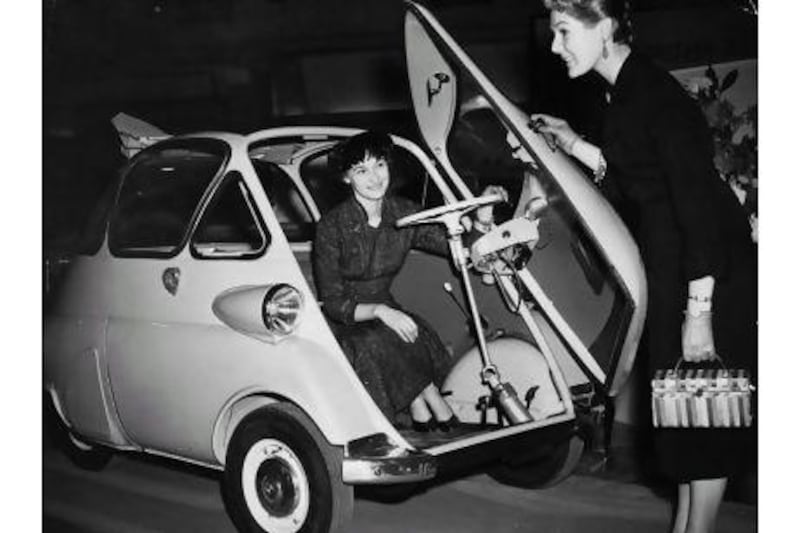Is it a car, is it a marsupial or is a motorcycle? That isn't as spurious a question as you may think (well except for the kangaroo reference) for, although the Isetta was the original "bubble car", it used a motorcycle engine and its popularity was largely because it could be driven on a motorcycle licence. It was cheap and it was certainly cheerful. Four decades before the Prius, this was the original hybrid and one of the greenest cars ever made.
In the austerity of post-war Europe, economy was at a premium, and this created a market for a microcar that was compact, comfy and cheap to run. Into this vacuum came the bubble car, an ingenuous, iconic design based around a three-wheeler truck. It caused a sensation on its 1953 unveiling in Turin, Italy, with its futuristic, quirky design and its utility and usability for the urban environment. It made compact cars like the Morris Minor look like presidential Packards and, in promising a fuel economy of 70 miles per gallon, it was the ultimate rationbook ride.
It was also something of a curio. It broke with convention by having no opening windows or doors. Instead the car was entered through the front, that paradoxically was more like a boot, the entirety of which swung open when a lever was turned. Unlike most budget cars, the Isetta was a convertible, although only to enable ventilation and to provide a means of escape in event of crash.
For a motoring public looking for inspiration from the future and parismony in the present, the Isetta was a breath of fresh air. It broke the mould of small cars by offering a fundamentally different alternative that was instantly destined to be a cult classic. It had a cartoon-like charm but soon won the respect of the motoring public, for unlike a Tom and Jerry jallopy the Isetta was designed for function rather than farce.
Despite early success, Iso chose to sell the licence to make the car. This was partly due to the introduction of the Fiat 500, which quickly became the compact car of choice in its native Italy. This led to Isettas being produced in Spain, Brazil, Belgium, France and England. But by far the most famous and long-running licencee was BMW, a marque better known for luxurious saloons and low-slung sports cars. BMW made some changes, fixing the lights to the body rather than the hatchfront (yes, that is a term I think I may have coined), and introducing its own 250cc, motorcycle-derived powerplant.
Between 1955 and 1962, BMW made more than 160,000 Isettas, making it the highest-selling single-cylinder car in history. With only 12hp, it made a Citroën 2CV seem like a gas-guzzling gorgon in comparison, but at a time when pennies were at a premium modest speed and pedestrian progress was an acceptable concession. Afterall, it was cheap, undeniably cute and its 85kph top speed was ample for short distances. Two adults could sit comfortably on its bench seat and a shopping basket or small case could be placed on the rear parcel shelf.
By the early 1960s, modest means had given way to conspicuous consumption, and owners once more wanted their cars to be stylish, speedy and substantial. Judged on these criteria, the Isetta appeared tardy and truncated. But although its commercial value declined and it slipped out of production in 1962, its cult value continued to build and it is now a highly prized and adorably peculiar classic car. Indeed, such is the demand for them that British firm Tri-Tech briefly brought them back in kit form or ready assembled as the Zetta. The complete version cost an eyebrow-raising £9,450 (Dh56,000).
In many ways, the Isetta was more similar in dimensions and design to a mobility buggy than a supermini. It could be driven without a car licence and slot into tiny gaps. Indeed a consignment of the model made under licence in Brighton, England, was bought by the NHS and adapted to be driven by wheelchair users. This civic experiment was short-lived but must surely rank as the first example of an equal- opportunity car years before access and mobility of the disabled were even issues on the political radar.
The Isetta is that rare car that is both an instant and an enduring classic. And despite its humble origins, let's be honest about it - it is far more loveable than the boxy, brutalist designs BMW now offer.
Top 5 small car revivals, mo8






